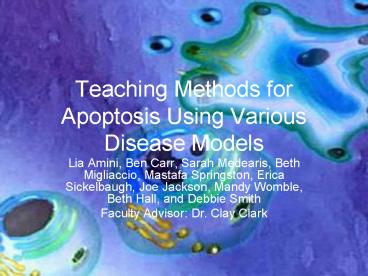Teaching Methods for Apoptosis Using Various Disease Models - PowerPoint PPT Presentation
1 / 20
Title:
Teaching Methods for Apoptosis Using Various Disease Models
Description:
Teaching Methods for Apoptosis Using Various Disease Models ... Tadpole tail. Destruction of damaged cells. Cancer. Mechanism. Initiation. Integration and Control ... – PowerPoint PPT presentation
Number of Views:366
Avg rating:3.0/5.0
Title: Teaching Methods for Apoptosis Using Various Disease Models
1
Teaching Methods for Apoptosis Using Various
Disease Models
- Lia Amini, Ben Carr, Sarah Medearis, Beth
Migliaccio, Mastafa Springston, Erica
Sickelbaugh, Joe Jackson, Mandy Womble, Beth
Hall, and Debbie Smith - Faculty Advisor Dr. Clay Clark
2
Overview of Apoptosis
- Lia Amini
- Ben Carr
- Sarah Medearis
3
Apoptosis
- Programmed cell death
- Applications
- Proper development
- Tadpole tail
- Destruction of damaged cells
- Cancer
- Mechanism
- Initiation
- Integration and Control
- Execution
- Phagocytosis
http//www.nst.co.il/images/side_img_f05.jpg
4
Extrinsic Pathway
- Signal binds to Membrane Receptors
- TNF-a
- Fas
- TRAIL
- Receptors migrate, co-aggregate
- This brings together DISC components inside the
cell - DISC activates capase-8, -10 this is
facilitated by FADD and TRADD - Caspase-8, -10 activate effector caspases
caspase-3, -6, and 7 - Caspase-8 can also cleave Bid, which triggers
mitochondrial damage. This essentially turns on
the intrinsic pathway as a result of extrinsic
pathway initiation.
5
Intrinsic Pathway
- Mitochondria mediated
- Caused by stress factors
- Depletion of growth factors
- DNA damage
- Misfolded protein
- Under mitochondrial stress
- Mitochondrial outer membrane becomes permeable
- Reactive oxygen species production increases
- Fission of the mitochondria occurs
6
Apoptosis and Multiple Sclerosis
- Beth Migliaccio
- Mandy Womble
7
Multiple Sclerosis
- Multiple Sclerosis is a widespread
neurodegenerative disease that is not fully
understood. - One in one thousand people in the United States
is affected by this disease usually in their late
twenties. - Two thirds of the people affected are females.
- People who live in high altitudes as children and
people who have a northern European heritage
seemed to be at a higher risk for the disease. - -It is thought that genetic factors may also
increase the risk.
Figure 1 Geographic distribution of Multiple
Sclerosis
Figure 2 MS Patient talking with doctor
8
Five Types of Multiple Sclerosis 1.
Relapsing-Remitting 2. Primary Progressive 3.
Secondary Progressive 4. Progressive-Relapsing 5
. Acute
Relapse-Remitting
Primary Progressive
Secondary Progressive
Progressive-Relapsing
9
- The myelin sheath covers the outside of our
nerve cells. - In MS the myelin sheath is
attacked by our own immune system. - Over time
this sheath begins to deteriorate causing the
nerve fiber underneath to be exposed.
Figure 2 Illustration of exposed fiber and
damaged myelin sheath
- This exposure to the environment causes
miscommunication between our brain and our
bodies. - This miscommunication causes common
symptoms of MS including episodic clumsiness and
blurred vision.
Figure 1 Breakdown of the nerve into neurons and
myelin sheath
10
A nerve is much like an electric circuit. Nerves
relay information for the brain to the body and
back much like a wire is a medium in which
electrons move. When a wire loses part of its
plastic covering it causes a short in the system
and electrons stop flowing When the myelin sheath
is damaged, the message is lost as it hits this
scared myelin and the nerve impulse hits this
dead end.
Figure 3 Video Illustration of nerve impulses in
a healthy nerve and a damaged nerve
11
Cell Death Pathways
- First possible cause is due to reactive oxygen
species which includes nitric oxide and hydrogen
peroxide. - A second cause is the Fas-Fas ligand system that
begins as an extrinsic pathway. - A third cause is possibly due to the Tumor
Necrosis Factor (TNF) and more specifically
TNF-a. - IFN-? is seen as a fourth possible cause of
oligodendrocytes cell death. - After a cell has experienced mitochondrial
dysfunction and overall apoptosis, the loss of
the cell leads to changes in the environment it
formally existed within.
12
Treatments
- Avonex
- Betaseron
- Copaxone
- Rebif
- Tysabri
13
Teaching!
- Worksheets
- Demonstration
- PowerPoint Presentation
14
Alzheimers Disease A neurodegenerative model
of cell death
- Beth Hall
- Debbie Smith
15
What is Alzheimers Disease?
- Progressive neurodegeneration
- Usually diagnosed during late 40s-50s
- Loss of cognitive function (memory loss,
personality changes, etc.) - Characterized by senile plaques and
neurofibrillary tangles
16
Statistics
- Over 4.5 million Americans suffer from AD
- 3rd most expensive disease to treat
- 1 in 10 Americans have a family member with AD
17
Pathway
- Gene Mutations increase risk of familial AD (APP
gene) and sporadic AD (APOE gene) - ? amyloid causes inflammation and glutamate
release - Mitochondrial Stress Endoplasmic Reticulum
failure - Oxidative stress activates caspase cascade,
causing the death of the cell
18
Treatments
- Genetic alterations-prevent ? amyloid proteins
from forming tangles and plaques - Block glutamate NMDA receptors-prevent
excitoxicity, mitochondrial overload and diminish
internal oxidative stress
19
Teaching Grades 6-8 about AD
- Worksheets
- Pathway steps-put the pictures of the steps in
order - AD Characteristics (ex senile plaques)-use
fill-in-the-blank to use terms in context - Lead the class through a True/False worksheet
that conveys important facts and statistics about
the disease
20
Statistics
In every nation where life expectancy has
increased, so has the incidence of Alzheimer's
disease.
- Further research is needed to find
- More effective treatments
- A possible cure
- Or a way to prevent AD altogether































